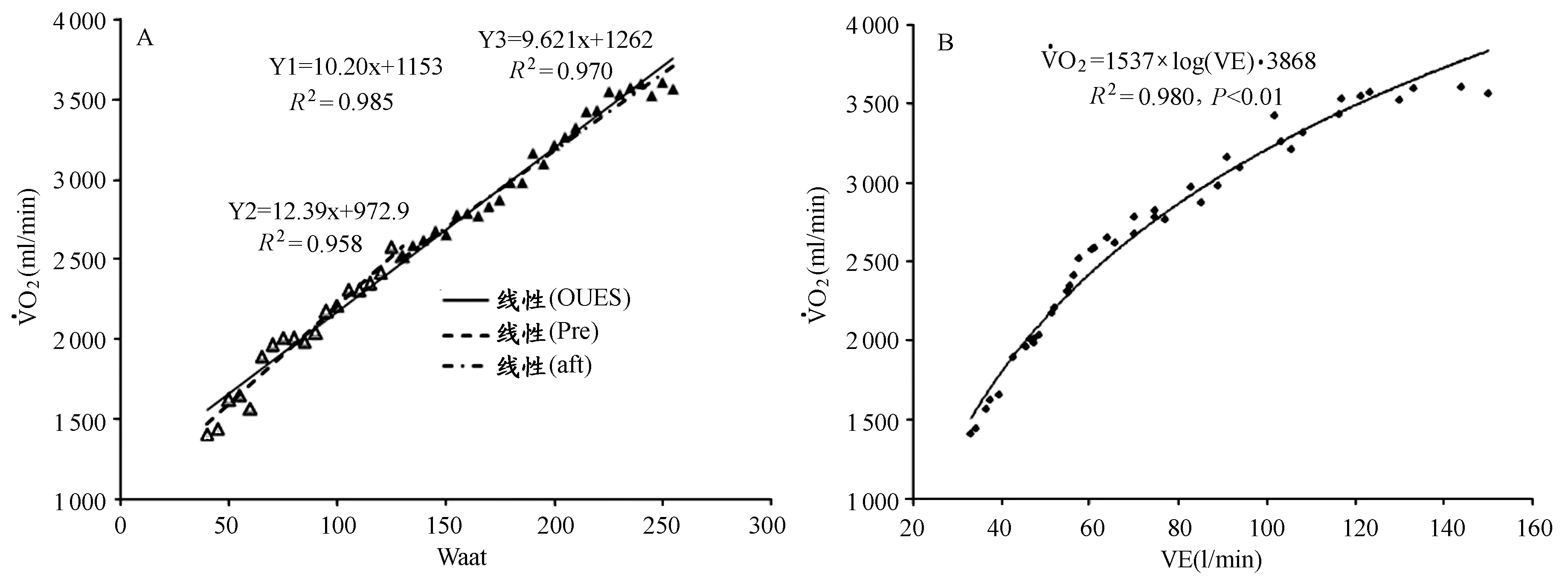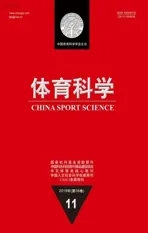不同运动模式下耗氧量动力特征参数关系研究
2015-02-14胡国鹏刘无逸
胡国鹏,冯 魏,冯 刚,王 振,刘无逸,孟 妍
不同运动模式下耗氧量动力特征参数关系研究
胡国鹏1,冯 魏1,冯 刚2,王 振1,刘无逸3,孟 妍2

耗氧量动力学;最大耗氧量;△效率;耗氧效率坡度
1 前言

2 研究对象与方法
2.1 研究对象
经筛选,符合研究要求的无心脑血管疾病史及症状、体力活动良好的34名男性受试者被招募,在受试者了解测试内容并明确其中风险与义务的情况下签订知情同意书(表1)。
2.2 实验步骤
34名受试者在2周内进行多次两种负荷方式的实验室测试和2次场地测试,测试内容分别为:斜坡式递增负荷力竭测试、中等强度动力学重复测试、400 m跑测试及3 000 m跑测试(场地测试作为另外一部分研究),每次测试之间间隔48 h。测试前及测试之间禁止大强度运动,测试前1天禁止饮酒及熬夜。正式测试前1周,34名受试者分别在不连续的3天到实验室体验两种测试方案并确定功率自行车的高度等参数。实验室测试中,用心肺测试系统监测呼吸代谢气体变化, 研究过程中,受试者始终在同一台功率车上并保持功率车高度等参数始终相同,功率自行车踏频维持在60 rpm。正式测试前,受试者进行5 min常规准备活动和拉伸。
表1 本研究受试对象人口学特征一览表
Table 1 The Subject’s Demographic Characteristics

年龄(岁)身高(cm)体重(kg)体脂率(%)21.6±1.4178.6±5.871.4±7.515.5±3.9
2.3 实验方法
每次实验室测试前1 h,心肺测试系统(Cosmed K4B2)按照仪器使用说明进行预热及室内气体、标准气体、呼吸延迟时间、标准气体容量等调试,提前在功率自行车上设定好每位受试者测试方案并保存。受试者在测试前24 h不得进行大强度剧烈运动,保证睡眠、休息充足并按预定时间准时到达实验室。
2.3.1 斜坡式递增负荷力竭测试(Ramp)

力竭判断标准:经鼓励无法继续运动,踏频连续30 s内达不到50 rpm;同时,3个评定员根据受试者出汗量、呼吸频率、呼吸商、RPE等进行互盲评定,3个测评员同时判定受试者力竭则视为完成测试,否则判定测试失败。

第1类标准:受试者力竭并经鼓励无法继续运动,呼吸频率及节奏发生明显变化,且3位评定员互盲评定均为力竭。
第2类标准:1)HR达到180次以上,不随强度的增加而增加;2)RER大于1.1;3)血乳酸大于8 mmmol/L;4)RPE大于17。

2.3.2 中等强度动力学测试及场地测试

场地测试分别在标准的400 m田径场进行,400 m测试和3 000 m测试之间间隔48 h,测试前禁止大强度运动。
2.4 主要实验器材
呼吸气体代谢分析系统(Italy,Cosmed K4B2),身体成分测试分析系统(韩国,Slimmanager- N40),功率自行车(Switzer,Monark 894),运动跑台(German、H/p/cosmos),血乳酸测试仪( German,H/p/cosmos),Polar心率表等。
2.5 主要测试及观察指标

2.6 耗氧量动力学的拟合及数理统计

(1)

OUES采用公式(2)拟合:
(2)

中等强度持续运动动力学参数拟合:
(3)


3 研究结果
3.1 斜坡式递增测试时耗氧量动力学变化特征

表2 本研究斜坡式递增测试时耗氧量动力学参数一览表
Table 2 The Parameter of Oxygen Uptake Kinetics in Ramp Incremental Exercise Test

X±SDRangR2VO2max(ml/min)3163±5132173~4276-VO2max/kg(ml/kg/min)44.0±6.333.6~57.4-VT-VO2(ml/min)2056±3791348~2967-VT-VO2/kg(ml/kg/min)29.0±5.419.8~38.3—A-slop(ml/min/W)10.4±1.37.6~14.00.932±0.151A-pre(ml/min/W)11.6±2.7*4.1~19.90.867±0.181A-aft(ml/min/W)9.2±2.42.7~12.80.907±0.081AOUES1474±234871~1951R2:0.977±0.012boues3198±20875384~3198(0.94-0.99),P<0.01
注:*表示A-pre与A-aft相比,差异显著(P<0.05)。

图1 本研究某一受试者递增负荷运动中耗氧动力学参数拟合过程曲线图
3.2 中等强度耗氧动力学变化特征

表3 本研究中等强度下耗氧量动力学指数函数特征一览表
Table 3 The Exponential Character of Oxygen Uptake Kinetics in Moderate -Intensity Exercise Test

(ml/min)Aslop(ml/min)δ(s)τ(s)X±SD576±771094±1795.6±2.256.3±9.8Rang402~757828~14150.2~9.639~80R2:0.96±0.02(0.84~0.98),P<0.01

图2 本研究中等强度持续负荷运动耗氧动力学拟合曲线图
3.3 两测试中耗氧动力学特征参数关系研究

表4 本研究两测试中动力学参数的相关分析一览表
Table 4 The Correlation Analysis of kinetic Parameters in the Two Exercise Tests

τ(s)VO2max(ml/min)VO2max/kg(ml/kg/min)VT-VO2VT-VO2/kgrPrPrPrPrPAOUES-0.2340.2310.7560.001**0.6000.001**0.7570.001**0.6570.001**Aslop0.0560.7710.6310.000**0.6500.000**0.3580.044*0.3160.079A-pre-0.3280.0770.2940.1020.3490.0520.3530.0480.3170.077A-aft0.2580.1690.5770.001**0.5810.000**0.1970.2810.1100.550
注:*表示P<0.05,相关具有显著性,**表示P<0.01,相关具有高度显著性。
4 讨论



本研究中的斜坡式递增负荷运动,其氧气和功率呈现典型的一次线性特征。研究也发现,当以通气无氧阈为切点时,通气阈前的△效率值和通气阈后△效率值存在显著差别,通气无氧阈值前后,其氧耗递增速度发生明显变化,通气无氧阈后期递增速度明显减少,其表现为△效率值在通气阈前大于通气阈后,其意义在于通气阈值后单位功率下耗氧值的下降,这也就意味着骨骼肌代谢方式发生了变化,这和通气阈值后肌肉募集比例的变化有关[19]。同样,这种动力学的变化与无氧阈以上持续运动中耗氧动力学的慢成分(slow component)具有极其相似的生理机制[3,22,26],我们在另外的研究中也发现这样的规律。
本研究推测认为,通气阈切点前后△效率值差值可能与机体有氧工作能力有关,但还需要进一步证明。而作为递增负荷中的另外一重要拟合参数OUES,虽然已经有研究指出是评价心肺耐力的有效指标[2,14],但是,从目前的研究来看,多集中在心脑血管疾病病人的心肺机能评定[11,15,21,25]方面,而在正常人群中进行的研究并不多见。从本研究来看,OUES拟合过程呈现典型的对数函数特征,拟合优度高达0.99,其均值也在正常参考值范围区间[8]。从上述分析来看,在斜坡式递增负荷测试中,不同的数据呈现不同的拟合特征,提示其内在生理机制的差异,OUES体现的是呼吸效率问题(氧气汲取能力),而△值呈现的是肌肉工作能力问题(单位功率的氧耗)。

如果把上述指标构建成运动能力的评价体系,其代表的生理意义各不相同,从对上述参数的分析。研究认为,中等强度下的氧气递增速率τ值更多反映的是机体从初始状态到某一有氧代谢稳态下的应答速度问题,反映机体从运动开始到快速调动机体机能并调适到某一稳态的能力;而在斜坡递增运动中,机体所面临的负荷刺激以某种固定模式增加(快速小负荷连续递增功率),体现的是在该递增模式下机体的连续调适氧气应答效率的问题。在机体长时间耐力运动中,需要不断调整能量状态,这种能量状态的转换既遵循两种模式下的规律,同时也涉及到更为深层的问题,如氧债问题、机体生成乳酸的清除及再利用能力等。因此,仅从两种理想化的模式去分析其运动能力问题尚存在一定局限性,这只能为研究者提供一个理解该问题的视角,其最终决定耐力的因素还涉及更多、更深层面的问题,但从目前研究及本研究来看,长时间的训练对上述指标有明显的改善作用[9,6]。
5 结论
[1]胡国鹏,王人卫.运动中摄氧量动力学的多相理论与生理机理[J].首都体育学院学报,2009,21(6):724-728.
[2]BABA R,NAGASHIMA M,GOTO M,etal.Oxygen uptake efficiency slope:A new index of cardiorespiratory functional reserve derived from the relation between oxygen uptake and minute ventilation during incremental exercise[J].J Am Coll Cardiol,1996,28(6):1567-1572.
[3]BARSTOW T J,JONES A M,NGUYEN P H,etal.Influence of muscle fiber type and pedal frequency on oxygen uptake kinetics of heavy exercise[J].J Appl Physiol,1996,81(4):1642-1650.
[4]BISI M C,STAGNI R,GNUDI G.Automatic detection of maximal oxygen uptake and ventilatory threshold[J].Comput Biol Med,2011,41(1):18-23.
[5]BOONE M J,BOURGOIS J.The oxygen uptake response to incremental ramp exercise[J].Sports Med,2012,42(6):511-526.
[6]BURGOMASTER K A,HUGHES S C,HEIGENHAUSER G J,etal.Six sessions of sprint interval training increases muscle oxidative potential and cycle endurance capacity in humans[J].J Appl Physiol,2005,98(6):1985-1990.
[7]BURNLEY M,JONES A M.Oxygen uptake kinetics as a determinant of sports performance[J].Eur J Sport Sci,2007,7(2):63-79.
[8]BUYS R,COECKELBERGHS E,VANHEES L,etal.The oxygen uptake efficiency slope in 1411 Caucasian healthy men and women aged 20-60 years:Reference values[J].Eur J Prev Cardiol,2015,22(3):356-363.
[9]CARTER H,JONES A M,Barstow T J,etal.Effect of endurance training on oxygen uptake kinetics during treadmill running[J].J Appl Physiol,2000,89(5):1744-1752.

[11]GADEMAN M G,SWENNE C A,Verwey H F,etal.Exercise training increases oxygen uptake efficiency slope in chronic heart failure[J].Eur J Cardiov Prev R,2008,15(2):140-144.
[12]HAKE T.History of developments in sport and exercise physiology:A.V.Hill,maximal oxygen uptake,and oxygen debt[J].J Sports Sci,2008,26(4):365-400.
[13]HEYEARD V H.Advanced Fitness Assessment and Exercise Prescription[M].Urbana:Human Kinetics,2014:55-88.
[14]HOLLENBERG M,TAGER I B.Oxygen uptake efficiency slope:an index of exercise performance and cardiopulmonary reserve requiring only submaximal exercise[J].J Am Coll Cardiol,2000,36(1):194-201.
[15]HOW O,AASUM E,SEVERSON D L,etal.Increased myocardial oxygen consumption reduces cardiac efficiency in diabetic mice[J].Diabetes, 2006,55(2):466-473.
[16]HUGHSON R L,INMAN M D.Oxygen uptake kinetics from ramp work tests:Variability of single test values[J].J Appl Physiol,1986,61(1):373-376.
[17]HUGHSON R L.Oxygen uptake kinetics:Historical perspective and future directions[J].Appl Physiol,Nut Metab,2009,34(5):840-850.
[18]JONES A M,BURNLEY M.Oxygen uptake kinetics:An underappreciated determinant of exercise performance[J].Int J Sports Physiol Perform, 2009,4(4):524-532.

[20]JONES A M,POOL D C.Oxygen Uptake Kinetics in Sports,Exericse and Medicine[M].Abingdon:Routledge,2005:1-3.
[21]LEWIS G D,LACHMNN J,CAMUSO J,etal.Sildenafil improves exercise hemodynamics and oxygen uptake in patients with systolic heart failure[J].Circulation, 2007,115(1):59-66.
[22]PRINGLE J S M,DOUST J H,Carter H,etal.Oxygen uptake kinetics during moderate,heavy and severe intensity 'submaximal' exercise in humans:The influence of muscle fibre type and capillarisation[J].Eur J Appl Physiol,2003,89(3):289-300.

[24]TSCHAKOVSKY M E.Is it or isn't it oxygen delivery? The debate over what limits oxygen uptake kinetics continues[J].Exe Sport Sci Rev, 2014,42(1):2-3.
[25]VAB LAETHEM C,BARTUNEK J,GOETHALS M,etal.Oxygen uptake efficiency slope,a new submaximal parameter in evaluating exercise capacity in chronic heart failure patients[J].Am Heart J,2005,149(1):175-180.

[27]WALSH M L,BANISTER E W.The influence of inspired oxygen on the oxygen uptake response to ramp exercise[J].Eur J Appl Physiol Occupat Physiol,1995,72(1-2):71-75.
[28]WHIPP B J,DAVIS J A,TORRES F,etal.A test to determine parameters of aerobic function during exercise[J].J Appl Physiol,1981,50(1):217-221.
[29]WHIPP B J,WASSERMAN K.Oxygen uptake kinetics for various intensities of constant-load work[J].J Appl Physiol,1972,33(3):351-356.
[30]XU F,RHODES E.Oxygen uptake kinetics during exercise[J].Sports Med,1999,27(5):313-317.
[31]YANO T,YUNOKI T,HORIUCHI M.Kinetics of oxygen uptake during decremental ramp exercise[J].J Sports Med Phys Fitn,2000,40(1):11-16.
Study on Characteristic Parameters of Oxygen Uptake Kinetics in Different Exercise Test Models
HU Guo-peng1,FENG Wei1,FENG Gang2,WANG Zhen1,LIU Wu-yi3,MENG Yan2
Objective:The characters and relationship of two typical exercise test models were researched in the study.Method:34 subject were recruited to finish two exercise test:one was incremental ramp exhaustive test,other was moderate- intensity constant test.The data about oxygen uptake was fitted by linear and nonlinear function models.Results:The goodnessR2of fitting oxygen consumption (O2) and power (Waat) was 0.932±0.151(P<0.01) by a linear function in the ramp test.The goodnessR2of fitting ventilation (VE) withO2was 0.977±0.012(P<0.01) by nonlinear logarithmic function in the ramp test.In the moderate repetitived test,goodnessR2of fit is 0.96±0.02(P<0.01),whereO2changed with time as exponential function.There were significant correlation(P<0.01) between Delta Efficiency,maximal oxygen uptake and VT,whose correlation coefficient was from 0.600 to 0.757;There was no significant correlation between OUES,Delta Efficiency and τ.Conclusion:In ramp test,O2was changed with Waat by typical linear features,while there was typical logarithmic function features between VE andO2, there are significant differences before and after VT in the △ efficiency;and in moderate-intensity constant test,O2showed a single exponential increase with time in response to the steady-state mode,there were different levels correlation between △ efficiency,OUES and VT,O2max.
oxygenuptakekinetics;maximaloxygenuptake;Deltaefficiency;oxygenuptakeefficiencyslop
2015-01-09;
2015-09-20
国家体育总局重点研究领域攻关课题(2012B067);华侨大学科研基金资助项目(13BS106)。
胡国鹏(1978-),男,河南南阳人,副教授,博士,主要研究方向为运动医学、运动与健康促进,Tel:(0595)22690897,E-mail:hugp@hqu.edu.cn;冯魏(1981-),女,河南濮阳人,讲师,主要研究方向为运动训练监控,Tel:(0595)22693589,E-mail:68323412@qq.com;冯刚(1963-),男,辽宁本溪人,主要研究方向为运动训练,Tel:(0335)8580818,E-mail :771209467@qq.com。
1.华侨大学 体育学院,福建 泉州,362021;2.国家体育总局 秦皇岛训练基地,河北 秦皇岛 066004;3.上海体育学院 运动科学学院,上海 200438 1.Huaqiao University,Quanzhou 362021,China;2.General Administration of Sport of China,Qinhuangdao 066004,China;3.Shanghai University of Sport,Shanghai 200438,China.
1000-677X(2015)11-0045-07
10.16469/j.css.201511007
G804.2
A
